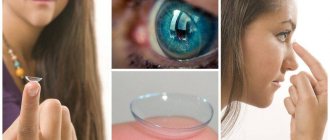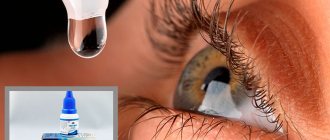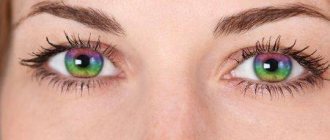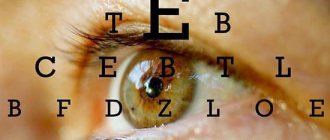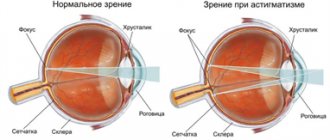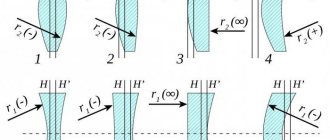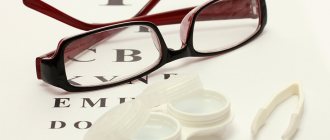"Smart" contact lenses: what are they?
Currently, the market for ophthalmological products offers contact lenses for the correction of various refractive errors: myopia, farsightedness, astigmatism, presbyopia, etc. These optical products operate on the same principle as glasses - they refract light and direct it to the retina. This provides improved vision and allows you to fully enjoy the picture of the world. Some models of contact correction products contain a coloring pigment in their structure, which completely or partially transforms the natural color of the iris. However, this will not surprise anyone. These products are used daily by millions of people around the world.
The largest technology corporations promise that in the near future there will be a real breakthrough in the field of contact correction tools, which will completely change the usual perception of reality.
In 2014, Samsung patented smart lenses in which a person could take pictures and instantly send them to the smartphone screen by simply blinking an eye. In the same year, Google Corporation proposed its innovative development - contact correction tools that allow measuring blood glucose levels and other vital signs. They are intended for people with diabetes and those who, for whatever reason, are forced to pay increased attention to their health. In 2020, Google specialists patented another concept - “smart” lenses made of biocompatible plastic, powered by solar energy. As planned, such optical products will allow their owner to quickly and easily obtain information about the environment: air temperature, humidity, the presence of allergens, etc. The idea of creating “smart” contact lenses was also supported by Sony. She patented a model that can not only take photos, but also record and play video by blinking.
The competition between the largest giants in the field of innovative lenses promises to be exciting.
Currently, it is not known for sure when these fantastic devices will hit the market and become available to consumers. However, it is safe to assume that these technologies will be implemented, since patent applications are filed by some of the largest technology companies in the world.
Which smart lenses are patented?
- Model from Samsung. Allows you to take pictures and synchronize them with your smartphone by blinking.
- Google smart contact lenses. The corporation has patented two models at once: lenses with the ability to measure blood glucose, as well as optical products powered by solar energy and providing information about the environment.
- "Smart" contact lenses from Sony. A model that allows you to record and playback video using blinking.
Additionally, in 2020, researchers from the Swiss State Institute of Technology announced that they are actively working on developing contact lenses with an optical zoom function. According to their idea, these products will also be controlled using a wink.
Features of glasses with adjustable diopters
The traditional way to correct vision is to wear glasses. However, due to the development of technology, they have also seriously changed.
Thus, the latest development is glasses with adjustable diopters. Those. Now it is possible to instantly adjust the optical power of the lens. Otherwise they are called adaptive glasses, which are a universal means for correcting visual acuity of almost any person.
People with poor vision often have to deal with a number of problems. One of these is the situation when a person’s eyes see differently. To correct this defect, you have to order glasses with different diopters, but this is not always possible and is much more expensive.
Another problem is the inconvenience associated with the visibility of objects at a certain distance. For example, myopia glasses are good for seeing distant objects, but they are too strong for reading. The opposite happens with farsightedness. And finally, the last one is vision deterioration, requiring replacement of lenses with stronger ones.
All of the above problems can be solved by universal glasses with adjustable focus, the design of which is a fairly simple mechanism. This is based on the operating principle of binoculars.
Design features
The main feature is the presence of two curved lenses adjacent to each other. On each edge there is a small wheel for adjusting the optical power, allowing you to adjust the image for your eyes individually.
When you turn the wheel, the lenses shift, which changes the diopter within the range from -6 to +3. This will allow people with both myopia and farsightedness to use such a device.
There are other models of adaptive glasses where the focus changes using an electrical impulse. These are electronic glasses from emPower. Operating principle: under the influence of current, the liquid crystal layer of the lens changes. However, the diopter change range does not exceed one.
Another modification is Superfocus hydraulic glasses, where there is a special liquid between the two lenses. The inner surface of the lens closest to the eye is flexible. When the amount of this liquid changes, the pressure changes accordingly. And under the influence of the latter, the soft lens bends. These glasses can be adjusted in the range from -4.5 to +3.5.
As you can see, the best option is to use paired lenses in glasses from the English company Adlens, which also have a good design.
Advantages and disadvantages
The advantages include:
- The versatility of the devices can be used by representatives of both sexes with almost any visual acuity.
- The adjustment is made individually for each eye in a few seconds.
- These glasses make it possible to visit the ophthalmologist less often.
- The special mechanism does not cause overstrain of the visual apparatus, compared to the use of bifocal glasses.
- Used for myopia and farsightedness.
- They contribute not only to correction, but also to improvement of vision.
- Convenient and reliable during operation.
Disadvantages of devices:
- Relatively high cost of original Adlens glasses (from 3,000 rubles).
- Mainly intended as spares rather than primary.
- Contraindicated in severe mental disorders and diseases of the visual organs requiring surgical intervention.
Be sure to consult an ophthalmologist before using.
Adjustable focus glasses are available without a prescription. However, you need to purchase them from official distributors, since the percentage of fakes is high.
In the Google Research Lab [x]
have brought to life another invention that brings us closer to the cyberpunk future. These are “smart” contact lenses with an integrated chip. It is expected that diabetics will be the first to wear such lenses.
The microcircuit is capable of measuring the sugar level in a tear once per second. The electronics are glued between two layers of soft material. An antenna is laid along the diameter, with the help of which the lens receives energy and sends sensor readings (you can view them on a smartphone). Now developers are trying to implement a small LED into the chip, which will give a signal if necessary.
Diabetes mellitus is a common disease that affects more than 5% of the world's population. It requires constant monitoring of blood sugar levels. If it falls below a certain value, damage to the kidneys, heart and eyes is possible. Not to mention side effects like losing control of the car at high speed or losing consciousness on the street.
Contact lenses
- the most convenient way to measure your sugar level. If they are not there, then you have to constantly donate blood or wear a subcutaneous sensor, which is probably not very pleasant. The blood glucose sensor is just the beginning. In the future, it is possible to create more advanced contact lenses with microcircuits of various functionality and an image projector on the retina.
Google LLC/USPTO, 2018
Google has filed a patent that describes an optical system for augmented reality glasses that allows an image to be projected into the eye directly from the lens of the glasses, rather than from an additional prism or other element.
Unlike virtual reality devices, augmented reality glasses and helmets allow the user to see the real world around them and only superimpose a synthetic image on it. Since such an overlay is quite a technically complex task, these devices currently cost much more than virtual reality headsets, and engineers have come up with many different designs for their optical system in recent years. For example, they solve the problem of using glasses together with augmented reality glasses to compensate for visual impairments in different ways. In their prototype glasses, Intel engineers used a laser projector installed in the temple of the glasses, which projects the image directly onto the retina. And Google in its glasses used a separate translucent block for projection, located in front of ordinary glasses.
In their patent application, Google engineers described a new design that allows an optical system to project an image into the eye directly into the lens of prescription or other eyeglasses. The lens in such a scheme consists of two compatible parts, one of which contains a light guide running from the edge of the lens to the center. A projection system consisting of a small screen and a prism is adjacent to the end of the light guide.
Diagram of the passage of rays from the screen to the eye
Google LLC/USPTO, 2018
Entering the light guide, rays from the screen pass to the center of the lens, namely to the area in which it borders the second part of the lens. At this boundary, the developers propose placing an array of reflective elements, which can be made of metal or translucent material. Since there will be free space between the reflective elements, the array will be translucent and will not greatly interfere with the view.
Two compatible lens halves
It's finally done! Google has taken another step towards the full implementation of its innovative development - “smart” contact lenses! Quite recently, a patent for lenses from Google was issued, an application for which was filed back... in 2012. Haven't you heard of such lenses? Then sit down comfortably, I will be happy to tell you about them.
Let's start with the fact that back in 2012, the company announced a joint development with the pharmaceutical corporation Novartis - special lenses for people with diabetes. It was planned to equip the new product with a miniature sensor and transmitter to constantly monitor glucose levels. Let's see what happened next.
Google Smart Contact Lenses: Features Overview
- Smart lenses for people with diabetes
In 2014, Google released an innovative device - Google Glass, running on the Android operating system. The device was controlled using voice commands. Such a gadget made it possible to take photos, record videos, search for information on the Internet, etc. In the same year, the company presented its innovative project to create smart lenses for people suffering from diabetes. Such optical products will be able to continuously measure blood glucose levels using second-by-second analysis of the composition of tear fluid. The received information will be transferred to an external device (smartphone, tablet, computer).
It is planned that Google's revolutionary lenses will be made of biocompatible material, so they can be used by people with high sensitivity of the cornea.
A small sensor, an antenna and a chip responsible for operating the software will be placed on the surface. An indicator light will also be included in the lens structure to alert the wearer when blood sugar levels are too low or too high. It is planned that recharging of such devices will be carried out via a radio channel from an external device. In the same way, Google lenses will be able to transfer data to external devices.
- Smart lenses powered by solar energy
In 2020, Google patented another futuristic device - contact lenses equipped with a photo detector that accumulates sunlight and then converts it into energy. As planned, such optical products will be built directly into the tissue of the eye and form a single whole with it.
Such a device will allow a person to receive comprehensive information about the environment, including air temperature, atmospheric pressure, the presence of various hazardous substances, including allergens, etc. The device will also allow continuous collection and transmission of data on a person’s body temperature and blood alcohol level. In addition, it is reported that there is a scanner on the surface of the lenses, which will provide the ability to collect data about any object that is in a person’s field of vision. One of the areas of application of this function will be scanning barcodes. The patent mentions the possibility of user identification using smart lenses. Thus, a person will no longer have to carry a passport or driver’s license with him in order to be authenticated when making a purchase, crossing a border, etc. Google representatives note that they are experiencing some difficulties in implementing this project, since there are currently no such miniature solar panels for placement in lenses.
Features of Google's Patented Smart Lenses:
- Measuring blood sugar levels;
- Measuring a person's body temperature and blood alcohol level;
- Collection of information about the environment: air temperature, atmospheric pressure, presence of allergens and other hazardous substances;
- Possibility of user identification;
- The ability to collect data about any object that is in a person’s field of vision (including scanning barcodes);
- Synchronize data with external devices (smartphone, tablet, computer).
A few words about the urgency of the problem
Diabetes mellitus is considered one of the most common diseases; more than 5% of the entire population (!) of the planet suffers from this disease. Such people are forced to constantly monitor their blood sugar levels, otherwise the consequences can be dire.
Important! The main difficulty is the constant change in glucose levels, which requires repeating systematic tests, mostly invasive. This, you see, is extremely inconvenient, which is why people do not use the glucometer as often as they should. And Google contact lenses should solve this problem.
Smart lenses measure blood sugar levels every second
Smart contact lenses from Samsung: review of a patented model
In 2014, almost simultaneously with Google, Samsung filed a patent application for the development of its revolutionary smart lenses. According to experts, this South Korean technology giant intends to create optical products to solve problems that the famous glasses of competitor Google Glass could not cope with.
The patent mentions that such optical products will be equipped with a miniature computer chip and camera, which will allow pictures to be taken without voice input, simply by blinking an eye.
The design of the device will also include an antenna for sending images to a mobile device for storage and viewing. In addition, such a “smart” lens will be able to display text and graphic information from the Internet in the user’s field of view - as is done in augmented reality systems, for example, in the film “Mission Impossible” with Tom Cruise. Samsung developers claim that these optical products will be especially useful for older people with weakened memory, as they will allow them to interactively receive data about surrounding objects and better navigate in space.
Features of Samsung's patented smart lenses:
- The ability to take pictures without voice input, just by blinking your eye;
- Synchronization with mobile devices (for data exchange);
- Displaying text and graphic information from the Internet about surrounding objects directly in the user’s field of vision.

